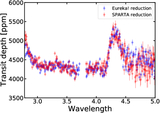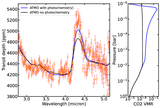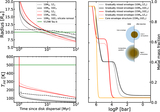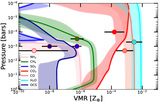Image Details

Caption: Figure 8.
Simulated thermal evolution models for V1298 Tau b for two interior structure scenarios: pure H/He atmosphere (Section 5.7.1) and an envelop with silicate vapor in equilibrium with a rocky core (Section 5.7.2). These models have been calculated using the AIOLOS code (M. Schulik & R. A. Booth 2023). The evolution of three key parameters presented: the internal temperature, the transit radii, and the core-powered mass-loss rate are presented in the left, middle, and right panels, respectively. In each panel, the gold line represents the current age of the planet (20 Myr), while the star in the middle panel depicts its observed TESS radius (A. D. Feinstein et al. 2022). The red curve is an evolution of a standard, pure H/He atmosphere, using realistic temperature profiles from AIOLOS. The atmospheric mass fraction is f = 0.08, with an internal temperature of 105 K. The blue curve represents an evolution with atmospheric structure calculated allowing for chemical equilibrium of silicates and the resulting superadiabatic temperature profiles. In the pure H/He atmosphere scenario, our models predict rapid contraction with V1298 Tau b contracting by ∼50% compared to its current size within the next 100 Myr. In the silicate vapor case, the planet does not undergo significant evolution and can maintain its size over a Gyr timescale.
Copyright and Terms & Conditions
© 2025. The Author(s). Published by the American Astronomical Society.












